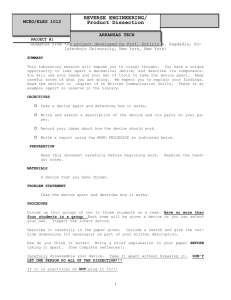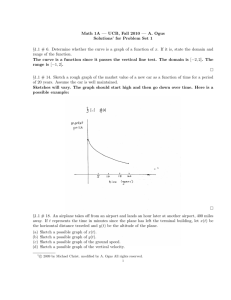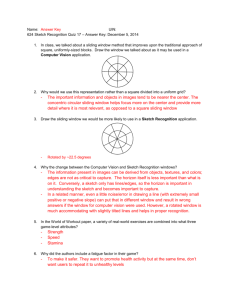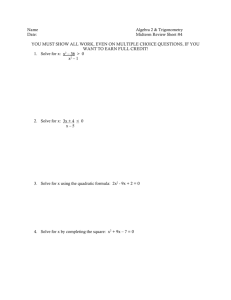Heideman: Concept Maps with Minute Sketches 1 11/29/10 Concept
advertisement
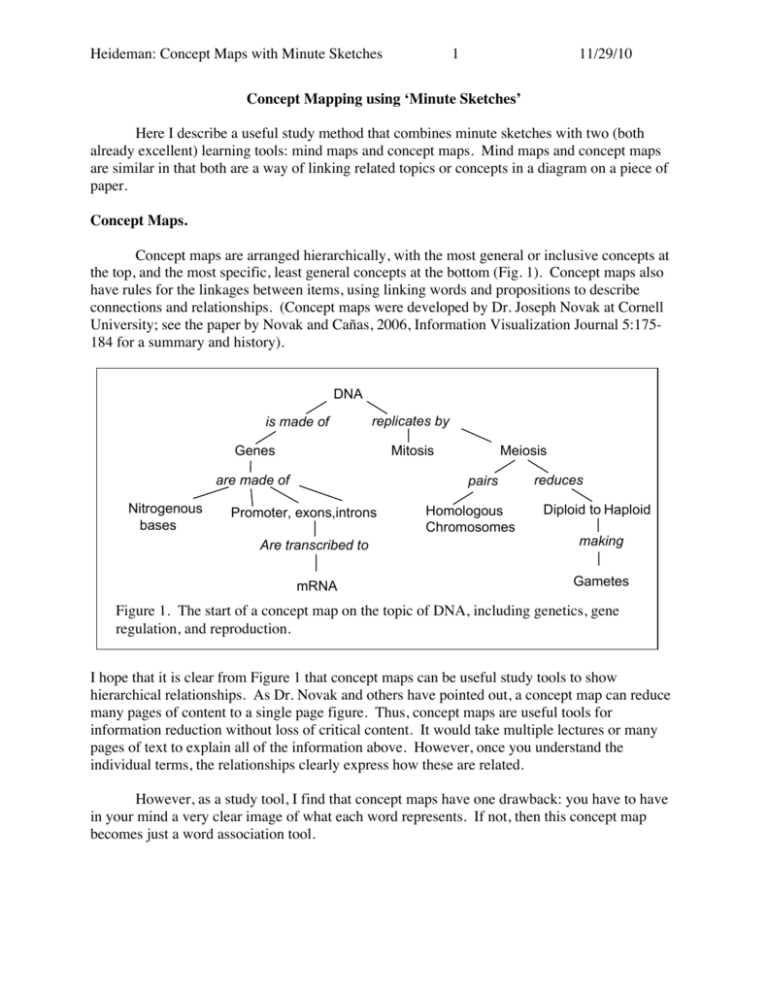
Heideman: Concept Maps with Minute Sketches 1 11/29/10 Concept Mapping using ‘Minute Sketches’ Here I describe a useful study method that combines minute sketches with two (both already excellent) learning tools: mind maps and concept maps. Mind maps and concept maps are similar in that both are a way of linking related topics or concepts in a diagram on a piece of paper. Concept Maps. Concept maps are arranged hierarchically, with the most general or inclusive concepts at the top, and the most specific, least general concepts at the bottom (Fig. 1). Concept maps also have rules for the linkages between items, using linking words and propositions to describe connections and relationships. (Concept maps were developed by Dr. Joseph Novak at Cornell University; see the paper by Novak and Cañas, 2006, Information Visualization Journal 5:175184 for a summary and history). DNA is made of replicates by Genes are made of Nitrogenous bases Meiosis Mitosis pairs Promoter, exons,introns Homologous Chromosomes reduces Diploid to Haploid Are transcribed to making mRNA Gametes Figure 1. The start of a concept map on the topic of DNA, including genetics, gene regulation, and reproduction. I hope that it is clear from Figure 1 that concept maps can be useful study tools to show hierarchical relationships. As Dr. Novak and others have pointed out, a concept map can reduce many pages of content to a single page figure. Thus, concept maps are useful tools for information reduction without loss of critical content. It would take multiple lectures or many pages of text to explain all of the information above. However, once you understand the individual terms, the relationships clearly express how these are related. However, as a study tool, I find that concept maps have one drawback: you have to have in your mind a very clear image of what each word represents. If not, then this concept map becomes just a word association tool. Heideman: Concept Maps with Minute Sketches 2 11/29/10 Mind Maps. Mind maps differ from concept maps in being roughly radial (usually), starting with some central concept in the middle, and connecting to other concepts via lines out toward the edges of a page (Fig. 2). In mind maps, lines that may or may not be labeled link the central concept to others, eventually forming a web of connections between the other concepts as well as with the central concept, and the lines may or may not be labeled. Both tools have a long history of use both in presentation of information and as learning tools. In uses I’ve found, both mind maps and concept maps represent their concepts using words (Figs. 1 and 2). Diploid Mitosis fertilization Meiosis Gametes 1n Haploid 1n Pairing Sister chromatids Homologous Chromosomes replicating Chromosome DNA Transcription Many genes Gene From exons mRNA Codon anticodon Translation Promoter, exons,introns Protein chain 1 Amino Acid tRNA Figure 2. The start of a mind map on the topic of DNA, including genetics, gene regulation, and reproduction. Sometimes, we do not want or need to emphasize hierarchical relationships, in which case a mind map may be a better choice than a concept map. However, as with concept maps, if you do not have a clear image of what each word represents, a mind map is only a word association tool. Heideman: Concept Maps with Minute Sketches 3 11/29/10 Minute Sketch Maps. Students who have learned to use minute sketches in their studying can find it useful to understand relationships among concepts by creating minute sketch maps (Fig. 3). In a minute sketch map, concepts are represented by minute sketches (see the description of minute sketches elsewhere on my website). In a minute sketch map, because each (or most) concepts are represented by images of what the concept really is, the connection lines relate structures to each other either by shared parts or by specific physical relationships. 2 Homologous Chromosomes Sister chromatids 3 3 2 2 n n 4 4 2 2 Chromosome 1 2 3 4 n DNA Many genes Gene i P e Promoter, exons,introns 3 3 4 4 AT CG GC TA Transcription From exons mRNA Translation U G C A Figure 3. The start of a minute sketch map on the topic of DNA, including genetics, gene regulation, and reproduction. The minute sketches show the parts of genes, the relationship of genes to chromosomes, and the key differences between DNA and RNA. Here, I’ve included words. A good minute sketch map will need few words, because the maker of the sketch will understand the relationships indicated by lines or arrows based on the sketches. In this example, promoters, exons and introns are all parts of genes, and many genes together form a chromosome. The arrow from gene to chromosome indicates that relationship. Chromosomes can replicate to form identical sister chromosomes (shown as two connected Heideman: Concept Maps with Minute Sketches 4 11/29/10 chromosomes that are clearly identical). In a diploid organism, there are two non-identical copies of each chromosome that are termed homologous (shown by two unconnected chromosomes, with two genes that are marked to indicate differences). DNA uses four nitrogenous bases (represented by A, T, C, and G) in a double stranded helix (represented by the wavy lines), with A binding to T and C binding to G. In the process of transcription (which could also be illustrated with a minute sketch, but in this case I have used the word), mRNA is produced, which is a single strand, and replaces T with U. Note that in Figure 3, the mRNA strand shown would have been transcribed from the left-hand strand of the DNA above (with the A in the DNA resulting in a U at that position in the growing mRNA, the C in the DNA resulting in a G in the next position in the growing mRNA, and so on). A look at the minute sketch map in Figure 4 shows how leaving out the words allows a user to focus on the physical relationships among concepts. 3 3 2 2 1 P n n 4 4 2 3 e i 4 2 2 n 3 3 4 4 AT CG GC TA U G C A Figure 4. The same minute sketch map on the topic of DNA, without words. If the student who creates this minute sketch understands each individual sketch, then the relationships are clear. In other studying, the student would associate the appropriate terms with each sketch. In drawing minute sketch maps, the goal is to develop a sense of the physical reality of the connections among the concepts. Heideman: Concept Maps with Minute Sketches 5 11/29/10 A good minute sketch map contains much more information than either a concept map or a mind map. In addition, a minute sketch map can be as fast to create as either a mind map or a concept map. Printing or writing words is often as slow or even slower than these sketches (note that most of the sketches actually have few lines than would the words when printed out). The most useful learning with a minute-sketch-map happens when it is first made by the user, adding words as they go. In this process, the user makes the connections between the physical relationships among concepts and associate the connections with the correct words. Later, recreating the sketch without words is faster, and the user may think the words without writing them on the sketch. In practice, minute sketches get messy. Users never make precisely the same minute sketch map for the same set of concepts, and lines go all over the place, crossing each other or passing in imaginary space around the back of a page to connect distant sketches. That’s because most concepts in science have many connections to many other concepts. A single page can’t handle them all. (Better would be a sketch in three or more dimensions, but I can’t figure out how to do that.) That’s OK. Each new version of a sketch will reinforce real connections. Drawing minute sketch maps helps develop motor memory (another term for skill memory or kinesthetic memory). Many students draw a minute sketch map only once or twice for any given set of topics. Even the one minute sketch map provides an easy way to understand the physical reality of relationships among many different concepts. However, for later review, a version of the map without words is actually most useful.


